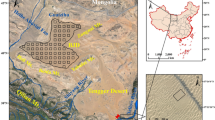Abstract
Aeolian dune-field patterns represent the spatial distribution of various combinations of landforms formed by the wind, and are self-organizing geomorphic features of the landscape. To explore how the desert landscape evolves, we selected a region with shifting sands in China’s Qaidam Basin, north of the Kunlun Mountains, which developed in the late Holocene. Using the method of geomorphic pattern analysis, we calculated dune-field pattern parameters in the study area and analyzed their spatial distribution. We found that the sandy land had a range of dune types that formed diverse spatial combinations, and the geomorphic patterns reflected the characteristics of a relatively early stage in the evolution of the dune field. The patterns at a given location were related to the distance from the sediment source area. By analyzing boundary conditions in this region, we developed a conceptual model of the pattern of geomorphic evolution of simple transverse dunes. This model provides insights into the geomorphic evolution process in the study region.







Similar content being viewed by others
References
Baas ACW (2007) Complex systems in aeolian geomorphology. Geomorphology 91(3–4):311–331
Bagnold RA (1941) The physics of blown sand and desert dunes. Chapman and Hall, New York
Bishop SR, Momiji H, Carretero-González R, Warren A (2002) Modelling desert dune fields based on discrete dynamics. Discrete Dyn Nat Soc 7(1):7–17
Breed CS, Fryberger SG, Andrews S, McCauley C, Lennartz F, Geber D, Horstman K (1979) Regional studies of sand seas using LANDSAT (ERTS) imagery. In: McKee ED (ed) A study of global sand seas. Professional Paper. United States Geological Survey, pp 305–398
Derickson D, Kocurek G, Ewing RC, Bristow C (2008) Origin of a complex and spatially diverse dune-field pattern, Algodones, southeastern California. Geomorphology 99:186–204
Dong S, Zhang Y, Long C, Yang Z, Ji Q, Wang T, Hu J, Chen X (2008) Jurassic tectonic revolution in China and new interpretation of the “Yanshan Movement”. Acta Geol Sin 82(2):334–347
Dong Z, Qian G, Luo W, Zhang Z, Xiao S, Zhao A (2009) Geomorphological hierarchies for complex mega-dunes and their implications for mega-dune evolution in the Badain Jaran Desert. Geomorphology 106(3–4):180–185
Dong Z, Su Z, Qian G, Luo W, Zhang Z, Wu J (2011) Aeolian geomorphology of the Kumtagh Desert. Science Press, Beijing (in Chinese with English summary)
Ewing RC, Kocurek G (2010) Aeolian dune-field pattern boundary conditions. Geomorphology 114(3):175–187
Ewing RC, Kocurek G, Lake LW (2006) Pattern analysis of dune-field parameters. Earth Surf Proc Land 31(9):1176–1191
Ewing RC, McDonald GD, Hayes AG (2015) Multi-spatial analysis of aeolian dune-field patterns. Geomorphology 240:44–53
Jerolmack DJ, Ewing RC, Falcini F, Martin RL, Masteller C, Phillips C, Reitz MD, Buynevich L (2012) Internal boundary layer model for the evolution of desert dune fields. Nat Geosci 5(3):206–209
Kocurek G, Ewing RC (2005) Aeolian dune field self-organization—implications for the formation of simple versus complex dune-field patterns. Geomorphology 72(1–4):94–105
Lancaster N (1995) Geomorphology of desert dunes. Routledge, London
Reitz MD, Jerolmack DJ, Ewing RC, Martin RL (2010) Barchan-parabolic dune pattern transition from vegetation stability threshold. Geophys Res Lett 37(19):L19402
Rubin DM, Hunter RE (1987) Bedform alignment in directionally varying flows. Science 237:276–278
Si Ha, Dong G, Wang G (1999) Morphodynamic study of reticulate dunes at southeastern fringe of the Tengger Desert. Sci China 42(2):207–215
Stone AEC (2013) Age and dynamics of the Namib Sand Sea: a review of chronological evidence and possible landscape development models. J Afr Earth Sc 82:70–87
Tao W (2003) Desert and desertification in China. Shijiazhuang (in Chinese with English summary)
Telfer MW, Hesse PP (2013) Palaeoenvironmental reconstructions from linear dunefields: recent progress, current challenges and future directions. Quatern Sci Rev 78:1–21
Tsoar H (1989) Linear dunes—forms and formation. Prog Phys Geogr 13(4):507–528
Wasson RJ, Hyde R (1983) Factors determining desert dune type. Nature 304:337–339
Werner BT (1995) Eolian dunes: computer simulations and attractor interpretation. Geology 23(12):1107–1110
Werner BT (1999) Complexity in natural landform patterns. Science 5411(284):102–104
Werner BT, Kocurek G (1997) Bed-form dynamics: does the tail wag the dog? Geology 25(9):771–774
Wilson IG (1971) Desert sandflow basins and a model for the development of ergs. Geogr J 137(2):180–199
Yin A, Harrison TM (2000) Geologic evolution of the Himalayan-Tibetan orogen. Annu Rev Earth Planet Sci 28:211–280
Yu L, Lai Z, An P (2013) OSL chronology and paleoclimatic implications of paleodunes in the middle and southwestern Qaidam Basin, Qinghai-Tibetan Plateau. Sci Cold Arid Reg 5(2):211–219
Zhou J, Zhu Y, Yuan C (2012) Origin and lateral migration of linear dunes in the Qaidam Basin of NW China revealed by dune sediments, internal structures, and optically stimulated luminescence ages, with implications for linear dunes on Titan. Geol Soc Am Bull 124(7–8):1147–1154
Acknowledgments
This study was supported by the China National Science Foundation (41171010, 41130533, and 41301003). We greatly appreciate the constructive comments from the anonymous reviewers.
Author information
Authors and Affiliations
Corresponding author
Rights and permissions
About this article
Cite this article
Li, C., Dong, Z., Cui, X. et al. Pattern analysis of simple transverse dunes in China’s Qaidam Basin, north of the Kunlun Mountains. Environ Earth Sci 75, 729 (2016). https://doi.org/10.1007/s12665-016-5610-9
Received:
Accepted:
Published:
DOI: https://doi.org/10.1007/s12665-016-5610-9



